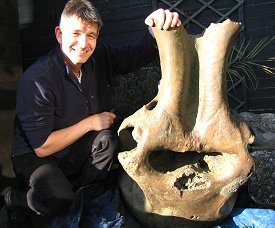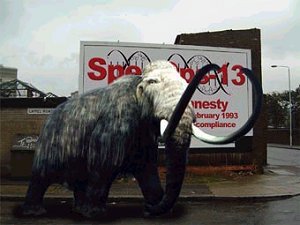Mammoth Discovery
What Swindon was really like 250,000 years ago
The first discovery of its kind for nearly two centuries was made by pure luck by local palaeontologist, Dr Neville Hollingworth, who works at the National Environment Research Council, whose headquarters are also in Swindon. "We didn't expect to find anything like this. It's quite amazing," he said at the time. "I saw a small piece of bone sticking out of the side of a clay face which had gravel in it. I started to dig and it got bigger and bigger. The skull is extremely well preserved and almost looks like modern bone," Hollingworth added. Cotswold Water Park Dr Hollingworth had been digging in a gravel pit at the Cotswold Water Park after an archeological team he was leading first found some bone fragments from Ice Age mammals in 1998. The skull took over four hours to dig out completely and is thought to be that of a female mammouth approximately 40 to 45 years-of-age.
Dr Hollingworth was also able to shed some light as to why woolly mammoths roamed the area around Swindon appromimately a quarter of a million years ago. ‘We already know that 240,000 years ago the Thames Valley was completely covered in vegetation. The river [Thames] was much bigger than today, with lots of sub-channels and streams criss-crossing around a main channel, all snaking across a very wide floodplain. ‘Animal and plant remains from that time, such as oak and alder, plus the mammoth bones and molluscs we also found, all indicate a much warmer climate, like southern France today. 'Mammoths, like modern elephants, lived in herds and needed to eat a lot to survive. They would have moved north in summer to the lush grasslands of the tundra and then south again in winter, all the time keeping an eye out for predators such as lions, wolves and wolverines.
'What we suggest is that this herd came to a crossing point, and one, maybe a baby, got swept downstream. Mammoths probably had strong parental instincts like today’s elephants, and the rest of the herd would have gone to rescue the one in trouble. 'As a consequence, this discovered mammoth may well have been swept away and drowned - its remains only to be discovered hundreds of thousands of years later!' Parallel Universe Mammoths first arrived in Britain after a dramatic drop in the level of the North Sea meant the they could migrate here from colder northerly climates. After being wiped out at the end of the Ice Age, the last ones remained in the extreme cold of northern Russia until approximately 4,000 years ago.
His character, Thursday Next is a literary detective that solves crimes in a parallel universe set in Swindon - a place where where books are more popular than football, history is not as we know it, reconstituted dodos roam the parks, mammoths ruin your flower beds, and where Thursday Next has to save the world. Find out more via the link below. |
|
||||||||
|
||||||||
|
||||||||
|
||||||||

















